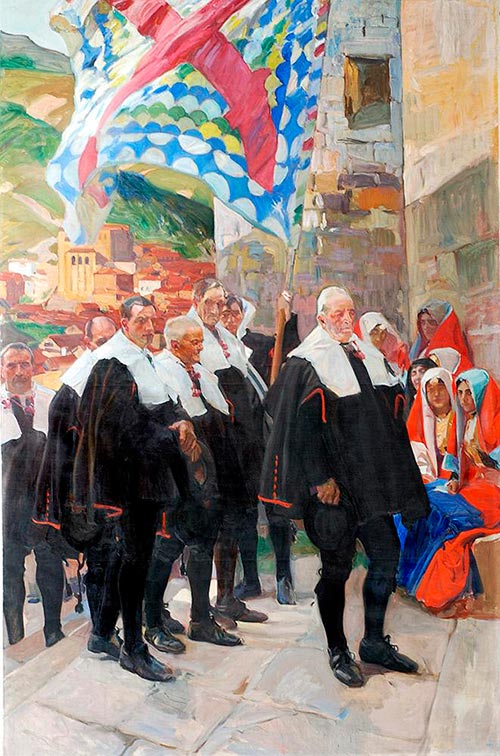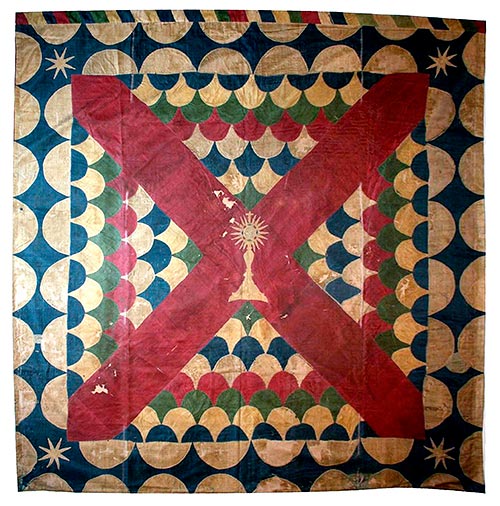The piece of the month of May 2022
A RONCALESE FLAG IN THE SOROLLA MUSEUM
José Ignacio Riezu Boj
University of Navarra
Sorolla in Roncal
Joaquín Sorolla, probably the Spanish painter of his time with the greatest international projection, held between 1892 and 1909 numerous exhibitions in Europe (Munich, Paris, Vienna, Berlin, Venice and London), but his greatest international success was the exhibition organized by The Hispanic Society of America in February 1909 in New York. After this success, the director of the society, Archer Milton Huntington, a great friend of Sorolla, commissioned him to decorate a new conference room of his society. The artist decided to show the traditions, landscapes and clothing of different Spanish regions. For eight years Sorolla traveled around the country collecting sketches in order to create his work. To make sketches of Navarre, Sorolla traveled to the village of Roncal between August 21 and 29, 1912. He stayed at the house of Gregorio Garjón, Gayarre's cousin, 72 years old, a widower and probably an acquaintance of Benlliure and Sorolla. There is a lot of documentation about his stay in Roncal, especially the extensive correspondence between the painter and his wife, to whom he wrote almost daily explaining his mood, local events or progress on his work.
Sorolla painted in Roncal three canvases that he calls "large" in his letters and two others that he calls "landscapes". In addition, in the Sorolla museum in Madrid are preserved eight other oil paintings with views of Roncal and another with a view of Isaba. In total we can count at least fourteen oil paintings that Sorolla painted during his stay in the valley. Along with these oil paintings, the museum conserves numerous sketches and annotations made in pencil, as well as photographic material of his stay in Roncal.
The panel "The Roncal Council".
With all this material collected in the nine days he spent in Roncal, Sorolla painted two years later, in the summer of 1914, while in Jaca, the large painting that finally represented Navarre in the Hispanic Society of America (Accession Number: A1802) (figure 1). It is the panel graduate "El concejo del Roncal", an oil painting 3.5 meters high and 2.3 meters wide. Despite its large dimensions, it is one of the four smallest panels he made, as it is placed occupying one of the four corners of the large room. In the painting we can see a group of seven men, who climb a staircase, dressed in the costume of Roncalese gala. One of them raises a large flag of bright colors. On a wall leaning back and on a bench seated, a group of six women in Roncal costume observe the procession. In the background there is a view of the village with the parish building standing out.

Vision of Spain: Navarra, The Council of Roncal. Oil on canvas.
The Hispanic Society of America, New York. Accession Number: A1802.
In the painting, the large flag that occupies the upper part of the composition is striking. We are also surprised that it is not the municipal flag, even more so knowing that Sorolla knew the town's ensign, as it appears several times among the material that the painter made in Roncal. We find it in one of the so-called large oil paintings now in a private collection graduate "Tipos del Roncal" and in two photographs in the Museum (references 83077 and CS2527).
The flag of the Sorolla Museum
Trying to understand this disparity, we have located in the Sorolla Museum a flag with issue inventory 60273 very similar to the one shown in the oil painting. Its card informs us that it is made of silk with taffeta binding with dimensions of 2.09 meters wide by 2.10 meters long (figure 2). Its central part is occupied by a large red cross with a red cross blade that, in the crossing of the arms, presents a very faded yellow monstrance. The bottom sample eight concentric rows of "scales" of different colors; from the outside to the inside: blue, yellow, green, red, white, blue, yellow and green. The exterior is formed by a large stripe with white scales facing each other on a blue background and the four corners offer white eight-pointed stars. The sheath or edge where it is attached to the mast has a series of small stripes of the same colors as the scales on the background. According to the museum technicians, the piece was acquired by Sorolla during his stay in the town of Roncal in the summer of 1912. Why did he use this flag for the New York panel instead of the municipal flag of Roncal, which, as we have seen, he also knew? The presence of this ensign in the painter's own house-studio surely induced the artist to use it in his work final on Navarre instead of using the ensign of Roncal, of which he only had the photographs or the oil painting mentioned above.

Flag. Sorolla Museum, Madrid. issue of inventory 60273.
Possible origin of the flag
At present, as far as I know, there is no flag with this design in the villages of the valley. What origin can we conjecture for this ensign? As can be seen in the photograph provided by the museum, this flag sample in the center is a representation of a sacramental monstrance. This fact induced some authors, with good criterion, to propose its relation with some confraternity, specifically with the confraternity of the Blessed Sacrament of Garde. Probably the author was unaware that the assistance brotherhood of the town of Roncal, the brotherhood of the Holy Faith, is also called the Holy Sacrament, so it is more logical to relate it to this brotherhood, since the painter was not staying in Garde, but in Roncal. However, and given that these confraternities are still active, we think it is difficult that they donated their ensign to the painter. We present here the hypothesis that this flag could have belonged to the brotherhood of San Martín, a brotherhood documented since 1563 that gathered all the clergymen of the valley and had its headquarters in the town of Roncal. In the XVII and XVIII centuries, the ecclesiastics of the valley reached almost seventy between abbots, vicars and beneficiaries. On the other hand, in 1912, the date of Sorolla's stay, this confraternity had probably been extinct for years -in the middle of the 19th century the parish benefices disappeared and only one parish priest attended the church of each village-, which could have led to the donation of the flag to the painter.
design of the flag
The design of this flag, like the municipal flags of most of the villages of Roncal, has its origin in the ensign of the local militias organized to defend the Pyrenean valleys of Navarre. These militias had the right to carry their own banner, taking as model the flags of the Spanish tercios that used the cross of Burgundy or the cross of St. Andrew (symbol of the Austrias) in red on a white background. Philip III, at the end of the 16th century, allowed the captains of the tercios to design their own banner keeping the Burgundy cross, so that they were enriched by complicated designs of borders and multicolored checkerboards. These militias were organized in brotherhoods of arms, which possibly caused the rest of the brotherhoods to take these standards as models for their ensigns.
Preparatory drawing
A magnificent drawing in the Hispanic Society (Accession Number: A1526) (figure 3) illustrates what the painter's first idea for the Navarre panel may have been. In the drawing we see a good issue of men holding large flags supported with the mast on the ground. There has been much speculation about the event that Sorolla represented in the Navarre panel. Some authors propose that it was the feast of the Virgin of the Castle, others that it was her octave, others that it was the tribute of the three cows. The presence in the preparatory drawing of a large issue of flags and men dressed in gala dresses leads me to think that it is about some general board of the valley. Precisely on August 24 the "board de San Bartolomé" is celebrated, one of the three ordinary meetings prescribed in the ordinances of the valley since the sixteenth century, in which the ban on baking bread ended and the cattle could graze in the fields already mowed. It is mandatory that the board is in Urzainqui. If Sorolla was in Roncal between August 21 and 29, it could well be attend to this meeting and inspire him the panel of New York.

outline of Mink of Spain: Navarra. Tempera on paper.
The Hispanic Society of America, New York. Accession Number: A1526.
SOURCES AND BIBLIOGRAPHY
file National Historic.
Parochial and municipal archives of the town of Roncal.
Hispanic Society of America. Access to collections.
Sorolla Museum. Access to collections.
LORENTE, V., PONS-SOROLLA, B. and MOYA, M, Epistolarios de Joaquín Sorolla II: Correspondencia con Clotilde García del Castillo, Barcelona, Anthropos, 2008.
PITARCH, C., Sorolla in the Roncal Valley. Piece of the month, January 14, Madrid, Museo Sorolla, 2014.
RIEZU-BOJ, J. I., "Alarde y bandera de Roncal", Diario de Navarra, La Semana Navarra, June 27, 2010, p. 13.
RODRÍGUEZ PEÑAS, T., "Banderas del valle del Roncal", Banderas, bulletin de la Sociedad Española de Vexilología, n.º 122, 2012, pp. 47-64.
